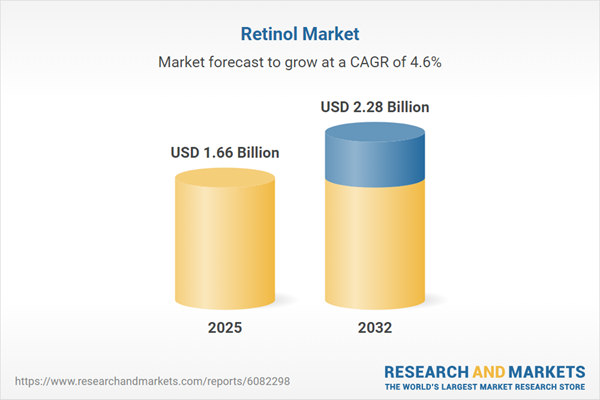Speak directly to the analyst to clarify any post sales queries you may have.
The retinol market is undergoing dynamic transformation, driven by rapid advances in formulation technologies, increased consumer health awareness, sustainability imperatives, and evolving global regulatory and trade environments. Senior leaders seeking to navigate this complex landscape require a clear understanding of both the foundational drivers and the emerging forces shaping this essential ingredient’s value chain.
Market Snapshot: Retinol Market Size, Growth, and Outlook
The retinol market grew from USD 1.59 billion in 2024 to USD 1.66 billion in 2025 and is projected to reach USD 2.28 billion by 2032, expanding at a CAGR of 4.56%. This growth is propelled by demand across global skincare, nutrition, and pharmaceutical sectors, supported by robust R&D pipelines and growing consumer emphasis on evidence-based wellness solutions. Ongoing investments by market leaders in manufacturing innovation and sustainable sourcing further bolster the sector’s expansion and resilience.
Scope & Segmentation of the Global Retinol Market
This report provides a comprehensive analysis of the retinol market, focused on the following segmentation and regional coverage:
- Type: Natural, Synthetic
- End-Form: Creams & Lotions, Gummies, Oil & Serum, Pills & Capsule
- Application: Animal Feed, Biochemistry & Pharmaceuticals, Dietary Supplements, Food & Beverages, Personal Care & Cosmetics
- Distribution Channel: Offline, Online
Regional analysis covers:
- Americas: North America (United States, Canada, Mexico); Latin America (Brazil, Argentina, Chile, Colombia, Peru)
- Europe, Middle East & Africa: Europe (United Kingdom, Germany, France, Russia, Italy, Spain, Netherlands, Sweden, Poland, Switzerland); Middle East (United Arab Emirates, Saudi Arabia, Qatar, Turkey, Israel); Africa (South Africa, Nigeria, Egypt, Kenya)
- Asia-Pacific: China, India, Japan, Australia, South Korea, Indonesia, Thailand, Malaysia, Singapore, Taiwan
Key market participants include Adisseo France SAS, BASF SE, Clariant AG, DSM-Firmenich AG, Shiseido Company, Limited, Symrise AG, and others from biotechnology, chemical manufacturing, and nutraceutical backgrounds.
Key Takeaways for Senior Leaders
- Technological innovation, particularly in encapsulation and fermentation, is enhancing product stability, safety, and sustainability, enabling premium and differentiated market offerings.
- Regulatory evolutions worldwide are steering manufacturers to optimize purity, formulation, and sourcing practices, underscoring the strategic relevance of compliant and adaptable operations.
- Consumer trends increasingly favor clean label retinol and advanced delivery forms, making it imperative for brands to align product development with transparency and efficacy expectations.
- Geographic dynamics vary, with Asia-Pacific serving as a hub for product customization and digital retail, while Europe and the Americas prioritize traceability and hybrid formulations integrating botanicals with science-backed retinoids.
- Competitive advantages are being shaped by collaborations between ingredient suppliers, biotech start-ups, and academia, fostering faster innovation cycles and expanding application versatility.
- Strategic supply chain management is critical, especially amid volatile raw material access and regulatory uncertainties in global trade.
Tariff Impact and Manufacturing Cost Structure
Heightened tariff measures introduced in 2025 are influencing sourcing decisions and cost structures, especially within the United States. Companies are increasingly investing in domestic manufacturing, negotiating trade alternatives, and forming upstream partnerships to buffer against supply chain disruptions and price volatility. This environment rewards agility and contingency planning to maintain market competitiveness and product availability.
Retinol Market Methodology & Data Sources
This research integrates primary interviews with value chain executives and in-depth secondary data from peer-reviewed scientific literature, regulatory filings, trade associations, and patent databases. Analytical tools such as SWOT, Porter's Five Forces, and PESTEL frameworks were applied. Cross-validation with financial disclosures and expert panels ensures robust and actionable insights for strategic decision-making.
Why This Report Matters for Decision-Makers
- Enable leadership teams to identify emerging technologies and market segments where returns on innovation and investment are highest.
- Support risk mitigation by clarifying supply chain resilience, policy shifts, and evolving consumer demands in key regions.
- Strengthen strategic planning with actionable intelligence on competitor positioning, collaborative models, and future growth hotspots.
Conclusion
As the retinol ecosystem evolves, organizations with a focus on technology adoption, supply agility, and consumer-centric innovation will be best placed to capture future opportunities. This report equips senior stakeholders with fact-driven intelligence to steer both near-term moves and long-range strategy in a competitive market.
Table of Contents
3. Executive Summary
4. Market Overview
7. Cumulative Impact of Artificial Intelligence 2025
Companies Mentioned
The companies profiled in this Retinol market report include:- Adisseo France SAS
- Alfa Chemistry by Thermo Fisher Scientific, Inc.
- Avanschem
- BASF SE
- Bizinbiz Technologies Private Limited
- Botanical Gold Inc.
- Chemyunion
- Clariant AG
- Conagen, Inc.
- Croda International Plc
- Divi's Laboratories Limited
- DSM-Firmenich AG
- Givaudan SA
- Infinity Ingredients
- MakingCosmetics Inc.
- Merck KGaA
- Nutraceuticals Group
- Shiseido Company, Limited
- Symrise AG
- Zhejiang NHU Co., Ltd.
Table Information
| Report Attribute | Details |
|---|---|
| No. of Pages | 184 |
| Published | November 2025 |
| Forecast Period | 2025 - 2032 |
| Estimated Market Value ( USD | $ 1.66 Billion |
| Forecasted Market Value ( USD | $ 2.28 Billion |
| Compound Annual Growth Rate | 4.5% |
| Regions Covered | Global |
| No. of Companies Mentioned | 21 |









